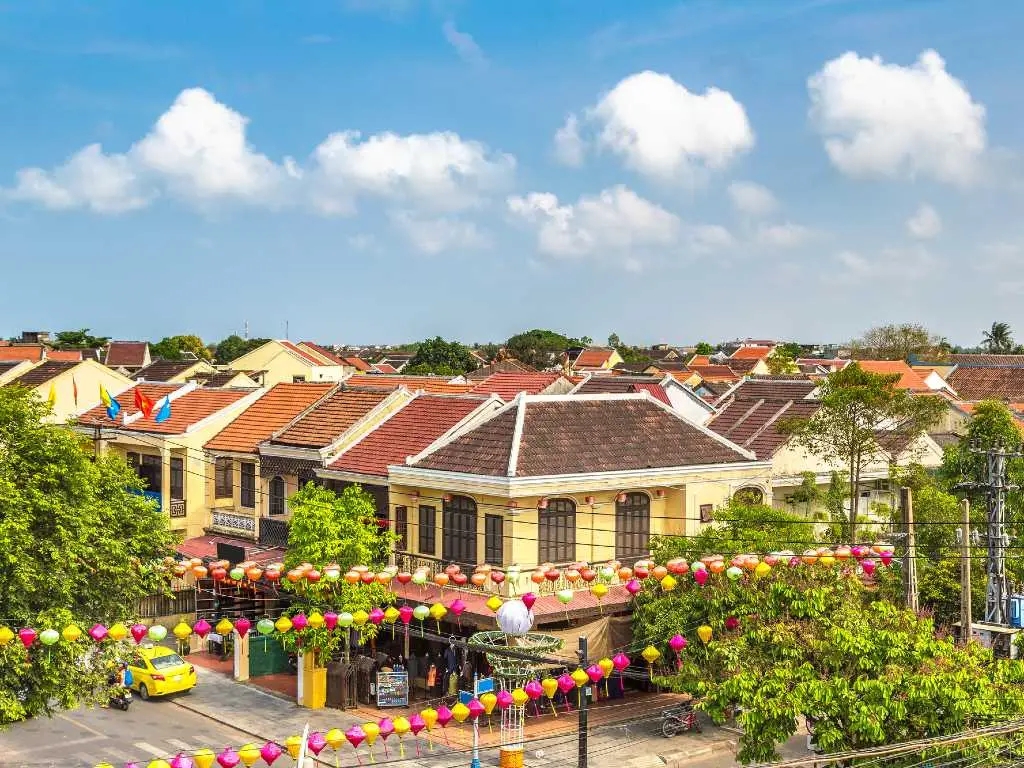
Hội An: The Ancient Vietnamese City Lit By Thousands of Lanterns
It was all yellow

There’s no question Hội An is one of the most beautiful places to visit in Vietnam. Its charming, pristinely preserved old town (also known as Ancient Town) has been a UNESCO World Heritage Site since 1999.
Known as “The Yellow City” of Vietnam, nearly every historic shophouse in the area is painted in the same yellow hue. According to local business owners, the distinctive color comes from an old-recipe powder paint that everyone uses to paint their façade.
Some say the yellow hue symbolizes wealth; some say royalty, and some say it keeps the houses cool in the intense Central Vietnamese heat. Either way, it makes the city uber-Instagrammable and one of the prettiest places for a stroll.
Lit by lanterns

Hội An has a thing for lanterns. You’ll see them hanging from almost every building, shophouse, restaurant, and hotel. They’re even strung overhead across the width of the winding streets. Their popularity stems from Japanese immigrants bringing them to the community in the 16th century. The Vietnamese then created their own spin on the light-source, using traditional bamboo for the structure and Vietnamese silk for the exterior. Since then, it has become a symbol of the town.
One of the best places to see and buy lanterns is night time at An Hội, a small island less than a one-minute walk across the bridge from Hội An’s old town. It’s said that each colored lantern has a different meaning. Red symbolizes love, happiness and luck; green means jealousy and lust; and black represents evil.
From port town to tourist hotspot
Hội An’s history dates back over 2,200 years. As far back as the 2nd century, Hội An was a busy and diverse trading port under the Champa Kingdom. It evolved to become a bustling merchant town and a crucial fixture on the Silk Road from the 16th century to the 19th century. This period brought Chinese, Japanese, Portuguese, Dutch, Filipino, and French influences to the tiny riverside town.
In the late 19th century, nearby Da Nang became the country's main shipping port, while under French rule Hội An languished as an administrative center. Due to a military agreement, it was luckily untouched during the Vietnam War, allowing it to become a thriving tourist center in the 1990s through today. On any given night, the small roads of Hội An’s old town are packed with local and international tourists sipping on tea from Mót Hội An (a popular café) and taking photographs.
The neverending well
Hội An has over 80 ancient wells dotting the city, but none is more famous than Ba Le Well, which is said to date back to 10th-century Cham times. Located in an alley off Phan Chu Trinh Street in the old town, it’s marked by a UNESCO sign.
The well has never been damaged or gone dry. Locals still visit every day to get water for tea and cooking, believing it makes their food taste better and even has medicinal qualities.
One of Hội An’s most famous dishes, cao lau (a noodle dish with pork and herbs), was once only made using the water from Ba Le Well. They say this is the secret to what makes these thick noodles taste so good, though how much of that is marketing and how much is truth is up for debate.
The symbol of the city

Every day an average of 4,000 people walk across Hội An’s Japanese Covered Bridge. Built in the late 16th century, it is one of the major symbols of Hội An and can be seen on Vietnam’s 20,000 dồng note. Mysteriously, the builder of the bridge is unknown to this day.
While the straightforward reason it was built was to connect the Japanese section of the old town with the Chinese section, folklore says it was also made to subdue the Japanese monster mamazu. The dragon-like creature’s head is in India, and its tail is in Japan, causing earthquakes. It’s said that Vietnam was located on its back, and the bridge was used to pin down the monster and stop earthquakes in Japan.
Over the past 400 years the small wooden bridge has been expertly restored several times; today visitors must pay to walk across and the money is used to maintain it. Inside, there is a small temple where locals come to pray to the Taoist god of weather.
The banh mi beloved by Anthony Bourdain
Vietnam was one of Anthony Bourdain’s favorite countries in the world. Now, biking around Hội An, you can’t help but notice that one of the town’s most popular banh mi restaurants has his face plastered on it.
“That’s a symphony in a sandwich,” he declared after biting into one of Bánh Mì Phượng’s creations on an episode of No Reservations. “The baguette alone is something of a miracle.”
This iconic sandwich, originally made in Saigon at a stall called Bánh Mì Hòa Mã in the 1950s, is a result of French colonialism in Vietnam. This famous fusion dish is made with a fresh baguette, paté, cucumber, herbs, pork and sauce.
The sandwiches are sold all over town, but Bourdain’s favorite was Bánh Mì Phượng and now it’s the only place where you’ll walk away with a warm baguette in a bag with Bourdain’s face on it—something he’d probably cringe over.
The city of 1,000 dishes?
The combination of cultures in Hội An makes it one of the country’s best places to eat. Locals like to brag that it has over 1,000 local dishes, but unlike in the neighboring city of Hue, that number hasn’t been proven.
Some of the city’s most famous meals include cao lau noodles, white rose dumplings, and Ớt Tương Triều Phát, a thick, spicy chili sauce made by one family from a 150-year-old Chinese recipe that can be found throughout the country.
Another one of Hội An’s famous dishes is Xia Ma, a healthy black sesame pudding made of black sesame seeds, sugar, Chinese medical herbs, and tapioca flour to make it thick. One of the oldest vendors is Mr. Thieu, who has been making and selling the pudding for over 90 years (now his daughter helps carry on the tradition). You can try it while on The Original Taste of Hội An food tour or find it at his home, which has been turned into a tourist destination.
Make way for bicycles

Cars are banned in the old town, making it one of the best places for a peaceful daytime stroll or bike ride. It’s estimated that there are over 100,000 bicycles in Hội An, with nearly every hotel, hostel, and homestay supplying them free of charge for guests to use.
It’s not only a great way to explore the town, but it’s also a part of the UNESCO destination’s environmentally-friendly initiative. In hopes of reducing air pollution and congestion for locals and tourists, the government has encouraged bicycle use in the city by supplying hundreds of free bicycles for people to use for 30-minutes. After that, it costs less than $1 per hour to keep pedaling.
A river runs through it

Like in most coastal towns, life in Hội An is centered around the waterfront. Once one of Asia’s most important trading ports, today, the Thu Bồn River is still a center for commerce, but instead of silks and ceramics, it’s floating lanterns and sampan rides.
While walking along the river, countless locals will ask you if you want a boat ride. They’ll then lead you to your own private sampan, a wooden boat covered in colorful lights and lanterns. Here, couples float down the river on a romantic boat ride.
During the monthly Lantern Festival, hundreds gather at the river to cast paper lanterns lit with candles down the river. Although not environmentally-friendly, it makes for a beautiful sight. Grab a seat at one of the dozens of restaurants and cafes along the river and watch as small lanterns float by.
Suit up!
There are more than 300 tailor shops scattered around Hội An. It’s a trade passed down through generations from Hội An’s history as a pivotal stop on the Silk Road over 300 years ago. Now the city has a worldwide reputation for creating beautiful and affordable outfits from wedding dresses to suits to kimonos.
Some stores specialize in certain materials like linen, and others are capable of turning multiple outfits around within 24 hours. Every local seems to have a recommendation; at each shop you’ll peruse the variety of fabrics, get measured by the tailor, and if needed, come back for a second fitting. It’s best to come with an exact photo of what you’d like designed so the tailor can copy it to suit your body, though many also have books full of designs you can choose from.
Cà phê, anyone?

Much like the baguette, coffee has also become a staple in Vietnam thanks to the French. Coffee or cà phê in Vietnam is strong, dark and intense—and the local cafe culture is just as strong.
In Hội An, locals can be found sitting, smoking and playing games in coffee shops from early morning till late at night. A few of Hội An’s best cafes include Phin Coffee, The Espresso Station and Sound of Silence Coffee Shop.
Since the coffee is so rich, many serve it over ice with condensed milk to sweeten it. Another option is a cold coconut coffee shake with ice, coffee, coconut milk, and condensed milk—super satisfying on a hot day. You can also find the famous egg coffee (which is made with frothy egg yolks and was created at Cafe Giang in Hanoi) at a few spots in Hội An, including Chu Chu and Phin Coffee. In the meantime, you can order some Vietnamese beans and make it at home.
Planning a visit? Check out our Vietnam visa guide, read about the Mù Cang Chải rice terraces, and join Going today to see deals to Hội An and cheap flights to tons of other destinations around the world.
More Asia destinations:
Published October 26, 2023
Last updated December 19, 2023
Articles you might like
View AllTreat your travel to cheap flights
Most deals are 40-90% off normal prices with great itineraries from the best airlines. If it's not an amazing deal, we won't send it. Sign up for free to start getting flight alerts.




